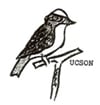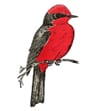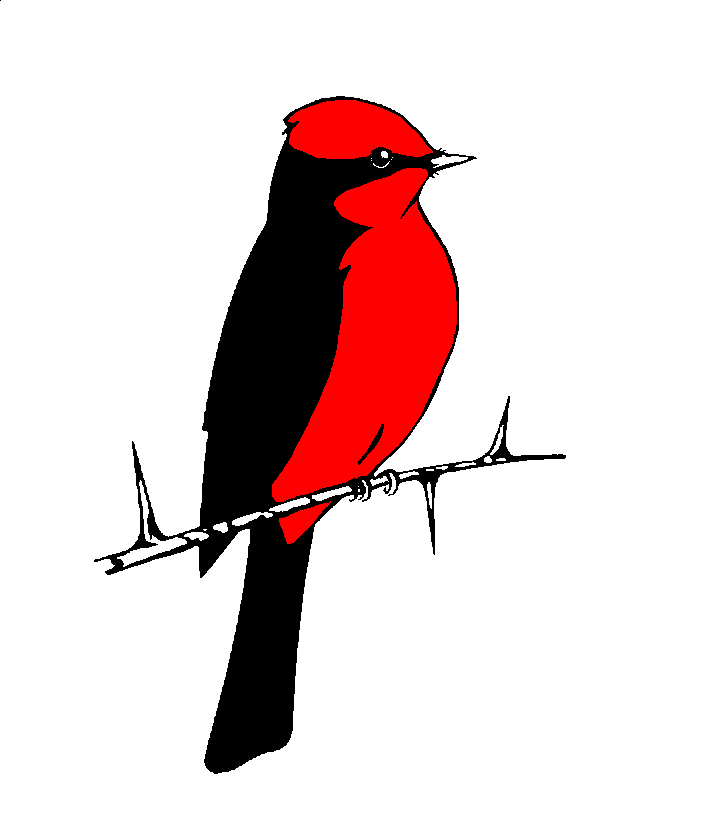Protect Birds & Their Habitats
Birding
Protect Birds & Their Habitats
Birding



Tucson Audubon’s original logos
Compiled by Doris Evans
The Tucson Audubon Society (TAS) held its very first meeting at Tucson High School January 1949. The 25 members elected Florence Thomberg president and set the annual dues at $1.00. The first order of business for the new club was to organize a birding field trip to be held the next month. However, it wasn’t until 1957 that regular monthly trips were scheduled. Today TAS trip leaders conduct many trips per month to locations across Southeast Arizona.
Also in 1957, the chapter newsletter took the name The Vermilion Flycatcher. The newsletter went from a few pages of trip summaries and conservation legislation news created on a typewriter and copied on a ditto machine to what it is today, a full-color magazine filled with beautiful bird photos and articles on local birds, environmental education, conservation issues, the many TAS programs, news of upcoming events, and more. In addition, TAS has a web site, multiple social media channels, a blog, and specialized e-newsletters bringing our news and messages to a world-wide audience.
In 1958, TAS published its first field checklist, Birds of Southeast Arizona. A few years later, the 60 members undertook a fund-raising program for The Nature Conservancy Patagonia-Sonoita Creek Sanctuary and donated $7000 toward the creation of the preserve.
In 1962, the 85 members took on more projects, committees were formed to accomplish specific goals, and TAS incorporated as a non-profit and became a chapter of National Audubon in 1964. That same year, TAS hosted the National Audubon Society convention in Tucson. Another national convention was held here in 1989.
Tucson Audubon has twice hosted Roger Tory Peterson—in 1974 for a book signing and talk, and in 1990 when he presented a slide program and signed his latest edition of Western Field Guide to Birds.
In 1970, a committee was formed to explore the idea of a nature workshop of desert ecology. May Watrous had been to an Audubon wildlife institute in the Rockies and was keenly interested in doing a similar program here. TAS’s first Institute of Desert Ecology (IDE) was held in spring of 1971 at Tanque Verde Guest Ranch with a full registration of 60 people. The venues changed over the years, but since 1983 it was held at Catalina State Park. The last IDE was in 2012.
In 1978, Beth Morgan initiated and directed the first Audubon Family Institute. These family outings continued for many years and explored various ecosystems in a variety of habitats, from the tidepools of Rocky Point to the Chiricahua Mountains.
By 1979, TAS had over 13,000 members and needed a home. The first office was opened at 30 North Tucson Blvd (where the DeConcini Building now stands). That year, Davis and Russell’s Birds of Southeast Arizona was printed. In 2015, TAS published the 8th Revised Edition of this popular guide to finding birds, now named Finding Birds in Southeast Arizona.
The grand opening of the first Nature Shop was held in 1983. Also that year, TAS hired its first executive director, Monica Matheny, who set up the business side of the shop among other duties. In 1984, Shirley Spitler, one of two shop volunteers, became the shop manager. The shop was in a tiny room with a three-section bookcase that held the merchandise, mostly field guides. The building was torn down in 1987 and TAS moved to its present location at 300 E. University Blvd. Things started small with only a few rooms occupied by TAS—the Nature Shop was in the room that now houses the library. But new space was acquired as TAS expanded with personnel, library needs, and meeting room requirements. Tucson Audubon was the first nonprofit to occupy space at the Historic Y—the former YWCA now supports over 25 nonprofits engaged in the arts, education, advocacy, and environmental activities. In 2006, an east side Nature Shop was opened at Agua Caliente Park and operated until 2017.
With a few books in the collection, Joan and Bob Tweit began the TAS library in 1982. Today the library has more than 1,200 titles and is used for research and reference by our members, educators, and others in search of natural history information. The collection can also be accessed online.
In 1986, David Lazaroff was hired to become the first education director. He initiated family workshops at the Mason Center property, set up teacher training workshops, and authored our first urban biology curriculum, Dr. Strangeplant, which uses urban weeds as a basis for teaching botany. Following David, TAS has had many education program managers including Lucia Hoerr Sayre, Erin Deely, Suzanne Dhruv, Carrie Dean, Bete Jones, and Bea Mendivil.
In the 1990’s, additional adult field studies in ecology were led by Cynthia Lindquist. These included the Institute of Tropical Ecology held in Alamos, Mexico, Sky Islands Institute in the Chiricahuas, and Marine and Coastal Institute in Rocky Point, Mexico.
After many years without an Executive Director, David Yetman was hired in 1992. He was later followed by Marci Steinberg, Wendy Laird, Kevin Dahl, Sonja Macys, Paul Green, Karen Fogas, Jonathan Lutz, Michael McDonald, and Melissa Fratello.
In the late 1980’s, the Mason Center was hosting its first programs: family outings featuring themes such as mammals, ethnobotany, star gazing, reptiles, desert discovery walks, and more. Mrs. Mason was still living on the property and often sat in on the lessons. In 1998, the Mason Center property of 20 acres was officially donated to TAS and many classes, walks, and events have been held at this beautiful desert location. The first permitted composting toilet in Pima County was built and opened on the property in 2012.
The Tucson Bird & Wildlife Festival was created and inaugurated in 2011 drawing hundreds of people from across the country and shining a spotlight on the region and its specialty birds. 155 species were seen that year. In 2024, the greatly expanded event now called the Southeast Arizona Birding Festival is a national fixture on the circuit pulling in over 900 paid registrants from 10 countries, almost 2,000 Nature Expo attendees, 60 exhibitors and sponsors, utilizing over 100 volunteers, and finding 227 bird species.
Renowned for its backyard birds and scenic location, Paton’s Hummingbird Haven in Patagonia was acquired by Tucson Audubon with generous help from the American Bird Conservancy (ABC) and Victor Emanuel Nature Tours early in 2014 and renamed the Paton Center for Hummingbirds. It was established as an international birding destination several decades earlier by the homeowners, Wally and Marion Paton. Many people and events conspired to bring the property safely under the direction of Tucson Audubon. It began when 104 year-old Ann Cullen Smith contacted Victor Emanuel with news that the house was for sale. Victor worked with George Fenwick, President of ABC, and Paul Green, Executive Director of TAS, to initiate an international fundraising campaign. Hundreds of supporters stepped forward to help complete the purchase and solidify the future of the Paton legacy.
In 2024, as Tucson Audubon turns 75 years old, the staff of over 40 people (not including Agency staff) and almost 300 volunteers regularly work in the Nature Shop, lead field trips, collect bird data, restore habitat by removing invasives and planting natives, create and maintain urban habitat, serve on the board and various committees, advocate for bird and human welfare, conduct research on local species such as the Desert Purple Martin, Elegant Trogon, Western Yellow-billed Cuckoo, and Lucy’s Warbler, reach out to youth and adults in the community, and support TAS in numerous other ways. Programs and offerings continue to expand. The Tucson Audubon Society is one of the most active Audubon chapters in the country and plays a vital role in environmental education and conservation in the community and beyond.
Tucson Audubon Mission Statement: Tucson Audubon Society inspires people to enjoy and protect birds through recreation, education, conservation, and restoration of the environment upon which we all depend.